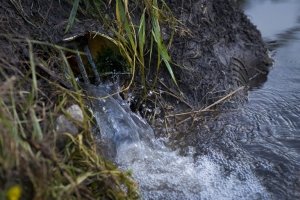Surprising Phosphorus Trends
July 29, 2016

Agricultural tiles empty into Iowa streams
Recent headlines have people talking about Iowa’s water quality and the need for improvement. It may stand to reason that much of this discussion focuses on water-quality problems. But we can find reasons for hope within the water monitoring data. We now know that total phosphorus concentrations have significantly decreased at a dozen sites on Iowa’s rivers. Phosphorus, along with nitrate, is commonly used as fertilizer; both contribute to nutrients in Iowa’s rivers and streams and ultimately all the way downstream to the Gulf of Mexico.
The study, conducted by Chao Wang, Kung-Sik Chan, and Keith Schilling and published recently in the Journal of Environmental Quality, analyzed trends in total phosphorus (TP) at 40 river monitoring sites in Iowa from 1998–2013. The sites chosen for the study were located beyond the influence of point sources (i.e., a single pollutant discharge site such as a factory or sewage treatment plant). They set out to look for trends in TP concentrations.
The results showed a downward trend in TP at 12 of the 40 sites. At the sampled rivers, TP concentrations were declining at an annual rate of about 2.6%. According to IIHR Research Engineer Keith Schilling, the trend correlates with similar decreases in sediment concentrations in Iowa rivers. “Conservation practices were probably responsible for that decrease,” Schilling explains. The sediment study covered almost a century, from 1917–2011. In that time, Schilling says, farming practices have become considerably more sophisticated.
“If you look at 1930s aerial photographs in watersheds that you know have a lot of slope, there isn’t a single [conservation] practice you could identify,” Schilling says. “You see how things were done, and it wasn’t pretty.” Today, many farmers routinely employ soil conservation practices such as minimal tillage, buffer strips, terraces, cover crops, and more. These practices have slowed the loss of Iowa’s topsoil to erosion, thus also reducing phosphorus in rivers and streams.

IIHR Research Engineer Keith Schilling and his colleagues Chao Wang and Kung-Sik Chan recently published a study showing a downward trend in total phosphorus at some of the monitoring sites they studied.
While Schilling agrees that this is good news, there’s a “but” that must be acknowledged. “The ‘but’ is the sobering realization that we have a long way to go based on recommendations in the the nutrient reduction strategy,” Schilling says. The strategy calls for a 45 percent reduction in TP from point- (treatment plants, etc.) and non-point sources (farm runoff); at 2.6 percent per year, it will take a long time to reach the goal.
“It’s encouraging that what we’re doing seems to be having some effect, and it’s a positive effect,” Schilling says. “We’ve just got to admit that it is going to take an enormous effort to get the phosphorus reductions we’re looking for.”
Water-quality monitoring data is providing new information that helps us target practices and behaviors that make improvements possible, Schilling says. “Don’t be afraid to collect monitoring data. It’s powerful, and without this, you’d have no idea where we really are.”
Check out IIHR’s Iowa Water-Quality Information System, an online platform that allows users to access real-time water-quality data and information such as nitrate, chlorophyll, temperature, and more.



